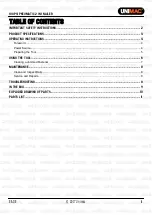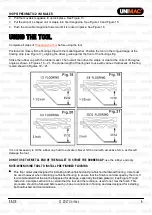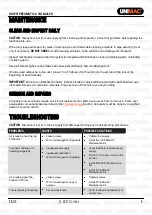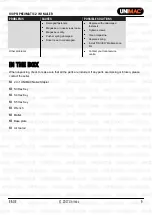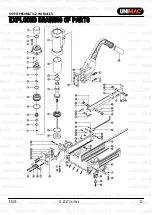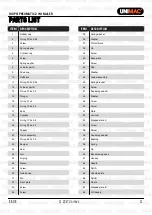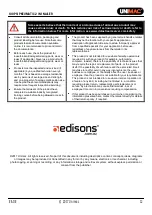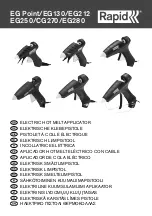
100psi Pneumatic 2 in 1 Nailer
E&OE
© 2017 Unimac
2
Important Safety Instructions
ENSURE THAT NO PART OF ANY HUMAN, ANIMAL OR CLOTHING IS PLACED IN/NEAR THE AREA
WHERE NAILS ARE FIRED OUT OF THE GUN, REGARDLESS OF WHETHER YOU THINK THE GUN IS
EMPTY OR LOADED WITH NAILS.
When using pneumatic tools, basic safety precautions should always be followed to reduce the risk of personal
injury. Please make certain that the person who is going to use this equipment carefully reads and understands
these instructions before starting operations.
READ AND FOLLOW ALL INSTRUCTIONS.
There are certain applications for which this tool was designed. It is strongly recommended that this tool NOT be
modified and /or used for any application other than for which it was designed.
1.
USE SAFETY GLASSES
To prevent eye injuries, the tool operator and all persons in the
work area must wear safety glasses with permanently-attached,
rigid, plastic side shields. These safety glasses must conform to
ANSI Z87.1 requirements (approved glasses have “Z87” printed
or stamped on them). See Figure 1.
2.
WEAR EAR PROTECTION
to safeguard against possible hearing
loss. See Figure1.
3.
OPERATOR AND BYSTANDERS SHOULD WEAR HARD HATS
to
safeguard against possible injuries. See Figure1.
4.
USE CLEAN, DRY, REGULATED
compressed air at 70 to 120 PSI,
(4.8 to 8.3 BAR). See Figure 2.
5.
DO NOT CONNECT TOOL
to pressure which potentially exceeds
200 PSI (13.8BAR)
6.
ONLY USE AIR HOSE THAT IS RATED
for a maximum working
pressure of 150 PSI or 150% of the maximum system pressure,
whichever is greater.
7.
NEVER USE OXYGEN, CARBON DIOXIDE
, combustible gases or
any other bottled gas as a power source for this tool: explosion
and serious personal injury could result. See Figure 3.
8.
CONNECT TOOL TO AIR SUPPLY HOSE
with a coupling that
removes all pressure from the tool when the coupling is
disconnected. See Figure 4.
9.
DISCONNECT TOOL FROM AIR SUPPLY HOSE
before doing tool
maintenance, clearing a jammed fastener, leaving the work area,
moving tool to another location, handing the tool to another
person, or making adjustments. See Figure 5.
10.
NEVER USE A TOOL
that is leaking air, has missing or damaged
parts, or requires repair. Make sure that all screws and caps are
securely tightened.
11.
DO NOT USE TOOL WITHOUT SAFETY WARNING LABEL
. If label
is missing, damaged or unreadable, contact your Service Centre
for a replacement. See Figure 6.


